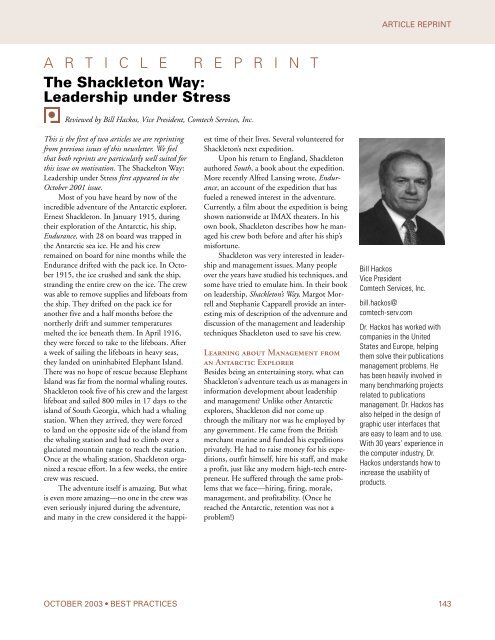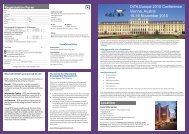October - Center for Information-Development Management
October - Center for Information-Development Management
October - Center for Information-Development Management
Create successful ePaper yourself
Turn your PDF publications into a flip-book with our unique Google optimized e-Paper software.
ARTICLE REPRINTA R T I C L E R E P R I N TThe Shackleton Way:Leadership under StressReviewed by Bill Hackos, Vice President, Comtech Services, Inc.This is the first of two articles we are reprintingfrom previous issues of this newsletter. We feelthat both reprints are particularly well suited <strong>for</strong>this issue on motivation. The Shackelton Way:Leadership under Stress first appeared in the<strong>October</strong> 2001 issue.Most of you have heard by now of theincredible adventure of the Antarctic explorer,Ernest Shackleton. In January 1915, duringtheir exploration of the Antarctic, his ship,Endurance, with 28 on board was trapped inthe Antarctic sea ice. He and his crewremained on board <strong>for</strong> nine months while theEndurance drifted with the pack ice. In <strong>October</strong>1915, the ice crushed and sank the ship,stranding the entire crew on the ice. The crewwas able to remove supplies and lifeboats fromthe ship. They drifted on the pack ice <strong>for</strong>another five and a half months be<strong>for</strong>e thenortherly drift and summer temperaturesmelted the ice beneath them. In April 1916,they were <strong>for</strong>ced to take to the lifeboats. Aftera week of sailing the lifeboats in heavy seas,they landed on uninhabited Elephant Island.There was no hope of rescue because ElephantIsland was far from the normal whaling routes.Shackleton took five of his crew and the largestlifeboat and sailed 800 miles in 17 days to theisland of South Georgia, which had a whalingstation. When they arrived, they were <strong>for</strong>cedto land on the opposite side of the island fromthe whaling station and had to climb over aglaciated mountain range to reach the station.Once at the whaling station, Shackleton organizeda rescue ef<strong>for</strong>t. In a few weeks, the entirecrew was rescued.The adventure itself is amazing. But whatis even more amazing—no one in the crew waseven seriously injured during the adventure,and many in the crew considered it the happiesttime of their lives. Several volunteered <strong>for</strong>Shackleton’s next expedition.Upon his return to England, Shackletonauthored South, a book about the expedition.More recently Alfred Lansing wrote, Endurance,an account of the expedition that hasfueled a renewed interest in the adventure.Currently, a film about the expedition is beingshown nationwide at IMAX theaters. In hisown book, Shackleton describes how he managedhis crew both be<strong>for</strong>e and after his ship’smis<strong>for</strong>tune.Shackleton was very interested in leadershipand management issues. Many peopleover the years have studied his techniques, andsome have tried to emulate him. In their bookon leadership, Shackleton’s Way, Margot Morrelland Stephanie Capparell provide an interestingmix of description of the adventure anddiscussion of the management and leadershiptechniques Shackleton used to save his crew.Learning about <strong>Management</strong> froman Antarctic ExplorerBesides being an entertaining story, what canShackleton's adventure teach us as managers inin<strong>for</strong>mation development about leadershipand management? Unlike other Antarcticexplorers, Shackleton did not come upthrough the military nor was he employed byany government. He came from the Britishmerchant marine and funded his expeditionsprivately. He had to raise money <strong>for</strong> his expeditions,outfit himself, hire his staff, and makea profit, just like any modern high-tech entrepreneur.He suffered through the same problemsthat we face—hiring, firing, morale,management, and profitability. (Once hereached the Antarctic, retention was not aproblem!)Bill HackosVice PresidentComtech Services, Inc.bill.hackos@comtech-serv.comDr. Hackos has worked withcompanies in the UnitedStates and Europe, helpingthem solve their publicationsmanagement problems. Hehas been heavily involved inmany benchmarking projectsrelated to publicationsmanagement. Dr. Hackos hasalso helped in the design ofgraphic user interfaces thatare easy to learn and to use.With 30 years’ experience inthe computer industry, Dr.Hackos understands how toincrease the usability ofproducts.OCTOBER 2003 • BEST PRACTICES 143





